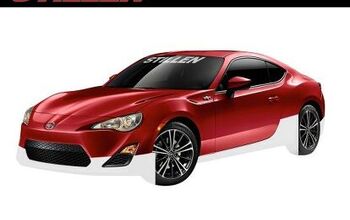Scion FR-S Sells Well, But It's Early
So often we hear analysts and fans excuse a car’s poor initial sales performance with a phrase like, “But it’s early.” Oddly, the very same phrase is legitimately used when discussing a new car’s surprisingly successful first month. In just its second month on sale, in just its first full month on sale, the Scion FR-S did not sell poorly.
Rarely has a car generated such an avid fan base before any independent testing had been completed. In a market that’s been starved by the disappearance of the Toyota Celica, Acura Integra, Honda Prelude, and Mazda RX-8; insulted by the long hiatus of Ford’s performance-oriented Focus; and offended by the weight gain of Mitsubishi’s Eclipse, a lightweight rear-wheel-drive sports car is a gift at $25,000.
Not that they’re direct rivals, but so-called sports sedans like the Volvo S60, Lexus IS, Acura TSX did not sell as frequently as the Scion last month. Mini’s best-selling variant, the Cooper and Cooper S hardtop, sold 2601 times in June. Volkswagen sold 1508 GTI hatchbacks plus 447 copies of the Golf R. Subaru Impreza WRX sales jumped 72% to 1138. Scion tC sales climbed 4% to 2128. The rear-wheel drive BMW 1-Series found 701 buyers. Sales of the Mazda MX-5 Miata improved 30% to 659. Honda CR-Z sales slid 58% to 409 units. Besides the American muscle car trio, the Hyundai Genesis Coupe (numbers for which are folded into the Genesis’s 3374-unit total), and the curious Hyundai Veloster, 3232 of which were sold in June, the FR-S fared better than other sporting cars.
As the best-selling Scion in June, FR-S sales reached 2684 units. That’s 32% of Scion’s U.S. total. Incidentally, in its first Canadian sales month, the FR-S delivered 51% of Scion’s volume.
Would a potential FR-S buyer consider acquiring a Mustang instead? Regardless, sales of the Ford pony car surged to 10,263 in June. Chevrolet Camaro sales rose to 9123. Dodge sold 4009 Challengers, marking that car’s best ever June.
One car we know to be a direct rival of the FR-S is the virtually identical Subaru BRZ. 271 BRZs left dealers in May, another 818 in June. Subaru never intended the BRZ to be the comparatively high-volume car that Scion’s FR-S now clearly is.
But it’s early. And to quote another painful analyst phrase, “Only time will tell.”
More by Timothy Cain
Latest Car Reviews
Read moreLatest Product Reviews
Read moreRecent Comments
- MaintenanceCosts Nobody here seems to acknowledge that there are multiple use cases for cars.Some people spend all their time driving all over the country and need every mile and minute of time savings. ICE cars are better for them right now.Some people only drive locally and fly when they travel. For them, there's probably a range number that works, and they don't really need more. For the uses for which we use our EV, that would be around 150 miles. The other thing about a low range requirement is it can make 120V charging viable. If you don't drive more than an average of about 40 miles/day, you can probably get enough electrons through a wall outlet. We spent over two years charging our Bolt only through 120V, while our house was getting rebuilt, and never had an issue.Those are extremes. There are all sorts of use cases in between, which probably represent the majority of drivers. For some users, what's needed is more range. But I think for most users, what's needed is better charging. Retrofit apartment garages like Tim's with 240V outlets at every spot. Install more L3 chargers in supermarket parking lots and alongside gas stations. Make chargers that work like Tesla Superchargers as ubiquitous as gas stations, and EV charging will not be an issue for most users.
- MaintenanceCosts I don't have an opinion on whether any one plant unionizing is the right answer, but the employees sure need to have the right to organize. Unions or the credible threat of unionization are the only thing, history has proven, that can keep employers honest. Without it, we've seen over and over, the employers have complete power over the workers and feel free to exploit the workers however they see fit. (And don't tell me "oh, the workers can just leave" - in an oligopolistic industry, working conditions quickly converge, and there's not another employer right around the corner.)
- Kjhkjlhkjhkljh kljhjkhjklhkjh [h3]Wake me up when it is a 1989 635Csi with a M88/3[/h3]
- BrandX "I can charge using the 240V outlets, sure, but it’s slow."No it's not. That's what all home chargers use - 240V.
- Jalop1991 does the odometer represent itself in an analog fashion? Will the numbers roll slowly and stop wherever, or do they just blink to the next number like any old boring modern car?































Comments
Join the conversation
This car is really a Subaru with a Toyota-engineered fuel delivery system put in there, even the Scion has Subaru printed on the inside of the fenders, in case there is any doubt, plus it's built at a Subaru plant.
As someone who bought a WRX last year, I can tell you the year-on-year increase is due to the supply pinch caused by the tsunami, and not anything to do with its popularity in the market.